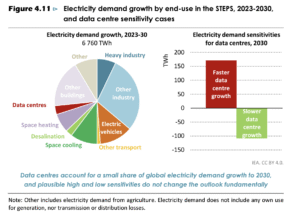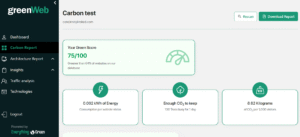The Green Web Movement in Hong Kong challenges us to rethink the internet’s hidden environmental cost—so the real question is, is your website running on clean, renewable energy or still relying on fossil fuels?
Introduction: The Digital Carbon Footprint
In our increasingly connected world, the internet has become the invisible backbone of modern life—yet its environmental impact is far from invisible. The digital infrastructure that powers our online experiences consumes massive amounts of energy, contributing significantly to global carbon emissions. Recent research reveals that global data centers are expected to consume approximately 536 terawatt-hours of electricity in 2025, accounting for around 2% of total global electricity consumption.
Even more striking, the average internet user’s digital consumption results in the emission of 229 kilograms of carbon dioxide per year—equivalent to a short-haul flight or driving approximately 600 miles in a typical car. The carbon footprint of our gadgets, the internet, and supporting systems now accounts for approximately 3.7% of global greenhouse gas emissions, with estimates ranging up to 10% depending on measurement methodologies.

Understanding the Green Web Movement
Defining Green Web Hosting
Green web hosting represents a fundamental shift in how digital infrastructure operates, prioritizing environmental sustainability without compromising performance. At its core, green web hosting involves powering web servers and data centers with renewable or zero-carbon energy sources such as solar, wind, hydroelectric, or geothermal power. However, the concept extends beyond just energy sources to encompass energy-efficient hardware, optimized cooling systems, carbon offset programs, and sustainable business practices.
The Green Web Foundation, a leading organization in this space, defines green hosting as services that can demonstrate they are powered by renewable energy through direct renewable energy procurement, renewable energy certificates (RECs), or by being located in regions with clean electricity grids.
Global Trends in Green Web Hosting
The green web movement has gained significant momentum globally, driven by both environmental concerns and economic incentives. In 2024, the hosting industry is experiencing a major shift toward sustainability, with eco-friendly hosting being identified as one of the top web hosting trends.
Key global trends include:
- Major cloud providers’ renewable commitments: Companies like Microsoft, Google, and Amazon have committed to becoming carbon negative or carbon neutral, with many already achieving significant milestones in renewable energy procurement.
- Energy efficiency innovations: Data centers are implementing advanced cooling technologies, including liquid cooling and AI-optimized climate control systems, reducing energy consumption by up to 30%.
- Green hosting proliferation: The number of verified green hosting providers has grown exponentially, with platforms like the Green Web Foundation tracking over 1,000 certified green hosting companies worldwide.
- Regulatory pressure: Governments worldwide are implementing regulations requiring data centers to report energy consumption and implement energy management systems.
Relevance to Hong Kong’s Context
Hong Kong’s unique position as an international business hub makes green web hosting particularly relevant. The city’s role in serving the Asia-Pacific region means that local hosting decisions can influence broader regional sustainability efforts. Additionally, Hong Kong’s sophisticated business community is increasingly prioritizing Environmental, Social, and Governance (ESG) criteria, making green hosting an important competitive differentiator.
The city’s integration with mainland China’s carbon neutrality goals also creates alignment opportunities, as businesses operating across the border seek consistent sustainability practices.
Hong Kong’s Energy Landscape and Web Hosting
Current Energy Sources Powering Data Centers
Hong Kong’s electricity generation presents both challenges and opportunities for green hosting. Currently, the city’s power generation mix consists of:
Natural gas: 52% – The dominant fuel source, providing cleaner combustion than coal
Nuclear: 31% – Imported from mainland China’s Daya Bay Nuclear Power Station
Coal: 16% – Being phased out as plants reach retirement
Renewable energy: 1% – Primarily solar, with limited wind due to geographic constraints

Regulatory and Infrastructure Challenges
Several key challenges impact green web hosting development in Hong Kong:
Hong Kong’s mountainous terrain and high population density severely limit large-scale renewable energy installations. Solar panels require large open areas for installation, while Hong Kong is fairly mountainous, making it difficult to find open and flat spaces in such a hilly place.
The Hong Kong government has developed the Green Data Centres Practice Guide, which provides best practices for energy-efficient and environmentally friendly data center operations. This comprehensive guide covers:
- Energy management systems
- Cooling system optimization
- Power system efficiency
- Green construction practices
- Monitoring and maintenance protocols
Benefits of Adopting Green Web Practices
Environmental Benefits
The environmental advantages of green web hosting extend far beyond simple carbon reduction:
(1)Direct Emissions Reduction
Green hosting directly reduces greenhouse gas emissions by replacing fossil fuel-powered electricity with renewable sources. By using renewable energy instead of fossil fuels, green hosting directly reduces the amount of greenhouse gases and carbon dioxide released into the atmosphere.
(2)Renewable Energy Market Stimulus
By investing in renewable energy, green hosting companies help stimulate the growth of the renewable energy sector, leading to greater investment in clean energy infrastructure and technology advancement.
Economic Advantages
Green hosting often provides economic benefits through:
Reduced energy costs: Renewable energy sources typically offer more stable, predictable pricing compared to fossil fuels
Energy efficiency gains: Green hosting providers often use more energy-efficient technologies, reducing overall operational costs
Future-proofing: Protection against carbon taxes and environmental regulations
Operational Efficiency
Many eco-friendly hosting providers use energy-efficient technologies that not only reduce environmental impact but also improve performance and reliability. These technologies often include advanced cooling systems, efficient server designs, and optimized data center management.
Corporate Social Responsibility (CSR) Benefits:
- Brand Reputation Enhancement
- Green web hosting significantly enhances corporate reputation by:
- Demonstrating environmental leadership and commitment to sustainability
- Attracting environmentally conscious customers and partners
- Improving ESG ratings and investor confidence
- Differentiating from competitors through authentic sustainability practices
How to Ensure Your Website Uses Clean Energy
Advanced Carbon Footprint Calculation Methodology
Understanding your website’s environmental impact requires sophisticated measurement approaches aligned with ICT emissions monitoring standards.
Everything Green’s Green Web Tool
We have developed innovative technology for calculating internet carbon emissions. Their patented Green Web tool provides localized carbon footprint assessment specifically designed for Hong Kong conditions.
The tool offers:
- Patented methodology for measuring website carbon emissions
- Real-time monitoring capabilities
- Hong Kong-specific energy grid calculations
- Integration with international ICT emissions standards

Technical Optimizations for Energy Efficiency
(1) Website Performance Optimization
- Image Optimization:
- Use modern formats like WebP or AVIF
- Implement responsive images with appropriate sizing
- Utilize lazy loading for non-critical images
- Code Efficiency:
- Minimize CSS and JavaScript files
- Remove unused code and dependencies
- Implement efficient caching strategies
- Content Delivery Networks (CDNs):
(2) Use green CDN providers powered by renewable energy:
- Optimize geographic distribution to reduce data travel distances
- Server-Side Optimizations
(3) Efficient Hosting Configurations:
- Choose energy-efficient server hardware
- Implement server-side caching
- Optimize database queries and structures
(4) Resource Management:
- Right-size server resources to avoid over-provisioning
- Implement auto-scaling to match demand
- Use serverless architectures where appropriate
Conclusion: Call to Action
The transition to green web hosting in Hong Kong is not just an environmental imperative—it’s a strategic business necessity. As global emissions from Information Communication Technology (ICT) could be as high as 2.1%–3.9% of total emissions, and with Hong Kong’s role as a regional digital hub, local action can have significant regional and global impact.
With the Asia Pacific region capturing around 30% of global data center capacity and expected to grow at a CAGR of 21%, Hong Kong businesses that act now will be positioned as sustainability leaders in the rapidly expanding digital economy.
The average website produces grams of CO₂ with every visit. Discover how much your site emits — and how to cut it down — with Everything Green.
References:
EcoMatcher. (n.d.). The climate cost of internet data. Retrieved September 16, 2025
HostArmada. (2024). *10 web hosting trends to look for in 2024*. Retrieved September 16, 2025
CLP Group. (n.d.). Power generation. Retrieved September 16, 2025
Hong Kong Energy Statistics & Facts. (n.d.). Clear The Air. Retrieved September 16, 2025
